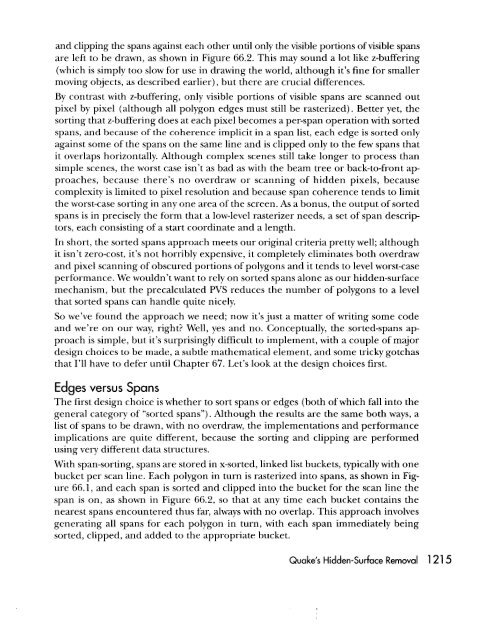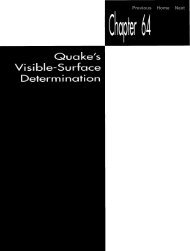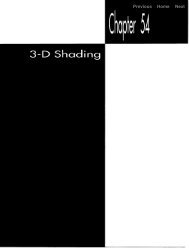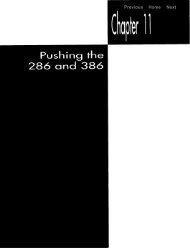Create successful ePaper yourself
Turn your PDF publications into a flip-book with our unique Google optimized e-Paper software.
and clipping the spans against each other until only the visible portions of visible spans<br />
are left to be drawn, as shown in Figure 66.2. This may sound a lot like z-buffering<br />
(which is simply too slow for use in drawing the world, although it’s fine for smaller<br />
moving objects, as described earlier), but there are crucial differences.<br />
By contrast with z-buffering, only visible portions of visible spans are scanned out<br />
pixel by pixel (although all polygon edges must still be rasterized). Better yet, the<br />
sorting that z-buffering does at each pixel becomes a per-span operation with sorted<br />
spans, and because of the coherence implicit in a span list, each edge is sorted only<br />
against some of the spans on the same line and is clipped only to the few spans that<br />
it overlaps horizontally. Although complex scenes still take longer to process than<br />
simple scenes, the worst case isn’t as bad as with the beam tree or back-to-front approaches,<br />
because there’s no overdraw or scanning of <strong>hidden</strong> pixels, because<br />
complexity is limited to pixel resolution and because span coherence tends to limit<br />
the worst-case sorting in any one area of the screen. As a bonus, the output of sorted<br />
spans is in precisely the form that a low-level rasterizer needs, a set of span descriptors,<br />
each consisting of a start coordinate and a length.<br />
In short, the sorted spans approach meets our original criteria pretty well; although<br />
it isn’t zero-cost, it’s not horribly expensive, it completely eliminates both overdraw<br />
and pixel scanning of obscured portions of polygons and it tends to level worst-case<br />
performance. We wouldn’t want to rely on sorted spans alone as our <strong>hidden</strong>-<strong>surface</strong><br />
mechanism, but the precalculated PVS reduces the number of polygons to a level<br />
that sorted spans can handle quite nicely.<br />
So we’ve found the approach we need; now it’s just a matter of writing some code<br />
and we’re on our way, right? Well, yes and no. Conceptually, the sorted-spans approach<br />
is simple, but it’s surprisingly difficult to implement, with a couple of major<br />
design choices to be made, a subtle mathematical element, and some tricky gotchas<br />
that I’ll have to defer until Chapter 67. Let’s look at the design choices first.<br />
Edges versus Spans<br />
The first design choice is whether to sort spans or edges (both of which fall into the<br />
general category of “sorted spans”). Although the results are the same both ways, a<br />
list of spans to be drawn, with no overdraw, the implementations and performance<br />
implications are quite different, because the sorting and clipping are performed<br />
using very different data structures.<br />
With span-sorting, spans are stored in x-sorted, linked list buckets, typically with one<br />
bucket per scan line. Each polygon in turn is rasterized into spans, as shown in Figure<br />
66.1, and each span is sorted and clipped into the bucket for the scan line the<br />
span is on, as shown in Figure 66.2, so that at any time each bucket contains the<br />
nearest spans encountered thus far, always with no overlap. This approach involves<br />
generating all spans for each polygon in turn, with each span immediately being<br />
sorted, clipped, and added to the appropriate bucket.<br />
Quake‘s Hidden-Surface Removal 1 21 5
















